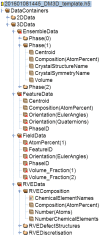Towards a metadata scheme for the description of materials - the description of microstructures
- PMID: 27877892
- PMCID: PMC5111567
- DOI: 10.1080/14686996.2016.1194166
Towards a metadata scheme for the description of materials - the description of microstructures
Abstract
The property of any material is essentially determined by its microstructure. Numerical models are increasingly the focus of modern engineering as helpful tools for tailoring and optimization of custom-designed microstructures by suitable processing and alloy design. A huge variety of software tools is available to predict various microstructural aspects for different materials. In the general frame of an integrated computational materials engineering (ICME) approach, these microstructure models provide the link between models operating at the atomistic or electronic scales, and models operating on the macroscopic scale of the component and its processing. In view of an improved interoperability of all these different tools it is highly desirable to establish a standardized nomenclature and methodology for the exchange of microstructure data. The scope of this article is to provide a comprehensive system of metadata descriptors for the description of a 3D microstructure. The presented descriptors are limited to a mere geometric description of a static microstructure and have to be complemented by further descriptors, e.g. for properties, numerical representations, kinetic data, and others in the future. Further attributes to each descriptor, e.g. on data origin, data uncertainty, and data validity range are being defined in ongoing work. The proposed descriptors are intended to be independent of any specific numerical representation. The descriptors defined in this article may serve as a first basis for standardization and will simplify the data exchange between different numerical models, as well as promote the integration of experimental data into numerical models of microstructures. An HDF5 template data file for a simple, three phase Al-Cu microstructure being based on the defined descriptors complements this article.
Keywords: 100 Materials; 200 Applications; 300 Processing/Synthesis and Recycling; 3D microstructures; 402 Multi-scale modeling; 403 CALPHAD/Phase field methods; 404 Materials informatics/Genomics; 500 Characterization; 60 New topics/Others; HDF5; Metadata; hierarchy; interoperability; multiphase materials; multiscale modelling; nomenclature; ontology; simulation chains.
Figures


















Similar articles
-
Efficient 3D porous microstructure reconstruction via Gaussian random field and hybrid optimization.J Microsc. 2013 Nov;252(2):135-48. doi: 10.1111/jmi.12077. Epub 2013 Aug 20. J Microsc. 2013. PMID: 23961976
-
Integrated Framework to Model Microstructure Evolution and Decipher the Microstructure-Property Relationship in Polymeric Porous Materials.ACS Appl Mater Interfaces. 2024 Jul 24;16(29):38442-38457. doi: 10.1021/acsami.4c03011. Epub 2024 Jul 15. ACS Appl Mater Interfaces. 2024. PMID: 39009042 Free PMC article.
-
Proceedings of the Second Workshop on Theory meets Industry (Erwin-Schrödinger-Institute (ESI), Vienna, Austria, 12-14 June 2007).J Phys Condens Matter. 2008 Feb 13;20(6):060301. doi: 10.1088/0953-8984/20/06/060301. Epub 2008 Jan 24. J Phys Condens Matter. 2008. PMID: 21693862
-
Integrating machine learning with advanced processing and characterization for polycrystalline materials: a methodology review and application to iron-based superconductors.Sci Technol Adv Mater. 2024 Dec 16;26(1):2436347. doi: 10.1080/14686996.2024.2436347. eCollection 2025. Sci Technol Adv Mater. 2024. PMID: 39845724 Free PMC article. Review.
-
Computational Multiscale Solvers for Continuum Approaches.Materials (Basel). 2019 Feb 26;12(5):691. doi: 10.3390/ma12050691. Materials (Basel). 2019. PMID: 30813637 Free PMC article. Review.
References
-
- Hall EO. The deformation and ageing of mild steel: iii discussion of results. Proc Phys Soc London. 1951;64:747–753. doi: 10.1088/0370-1301/64/9/303. - DOI
-
- Petch NJ. The cleavage strength of polycrystals. J Iron Steel Inst London. 1953;173:25–28.
-
- Laschet G, Fayek P, Henke T, et al. Derivation of anisotropic flow curves of ferrite–pearlite pipeline steel via a two-level homogenisation scheme. Mater Sci Eng A. 2013;566:143–156.
-
- Böttger B, Haberstroh C, Giesselmann N. Cross-permeability of the semisolid region in directional solidification: a combined phase-field and lattice-boltzmann simulation approach. JOMM. 2016;68(1):27–36. doi: 10.1007/s11837-015-1690-3. - DOI
-
- Böttger B, Apel M, Santillana B, et al. Relationship between solidification microstructure and hot cracking susceptibility for continuous casting of low-carbon and high-strength low-alloyed steels: a phase-field study. Metall Mater Trans A. 2013;44:3765. doi: 10.1007/s11661-013-1732-9. - DOI
LinkOut - more resources
Full Text Sources
Other Literature Sources
